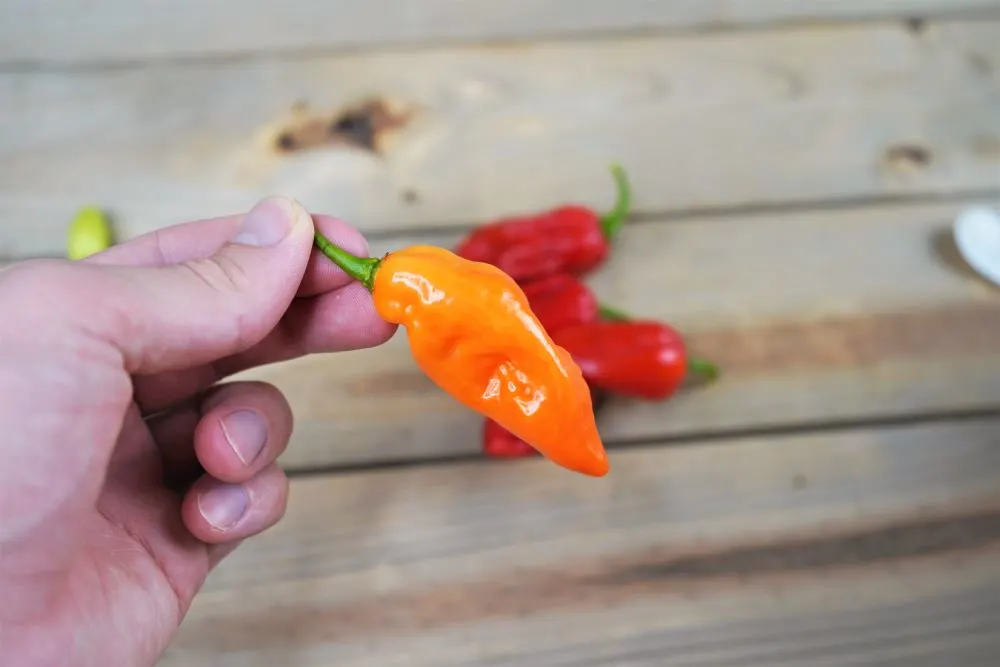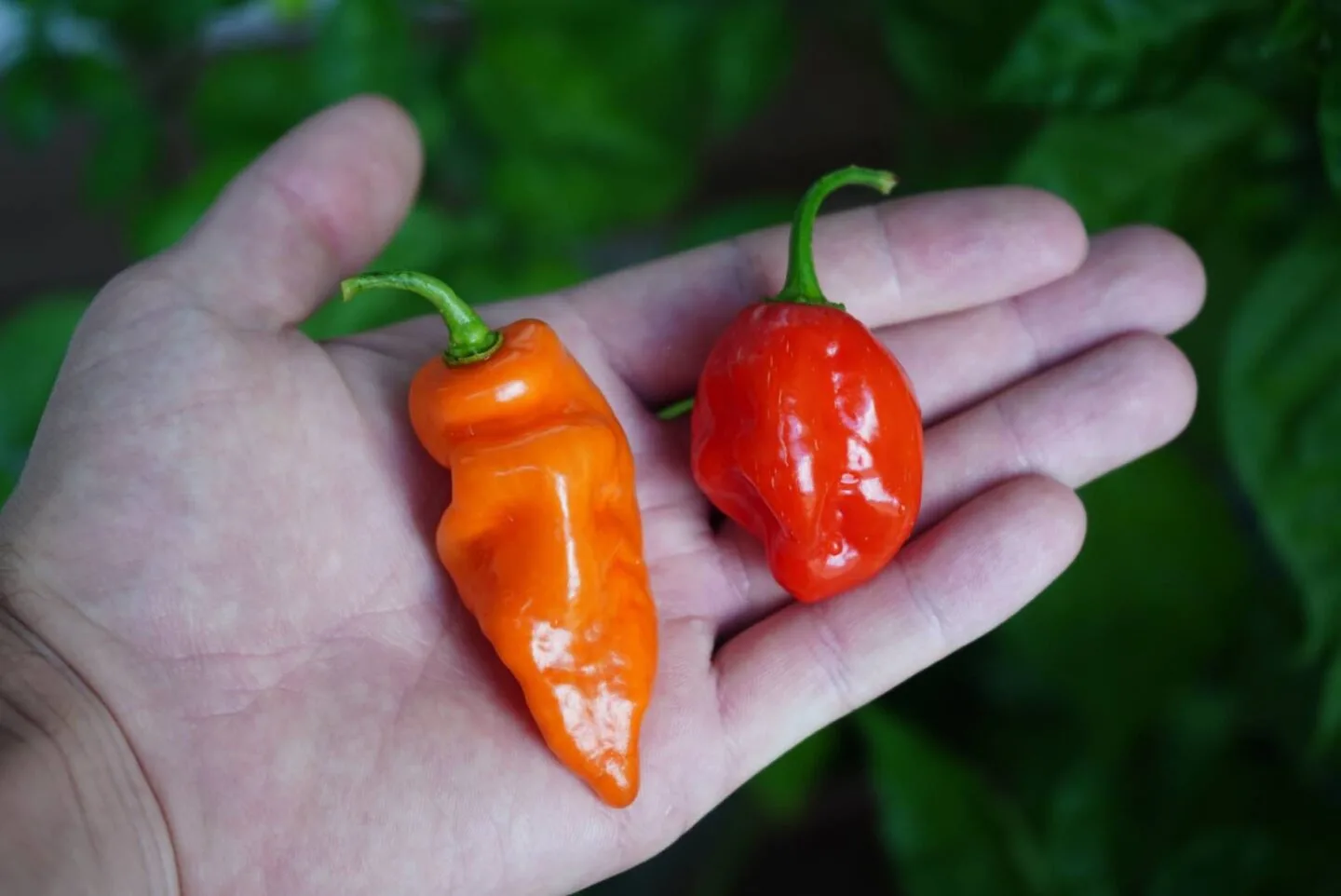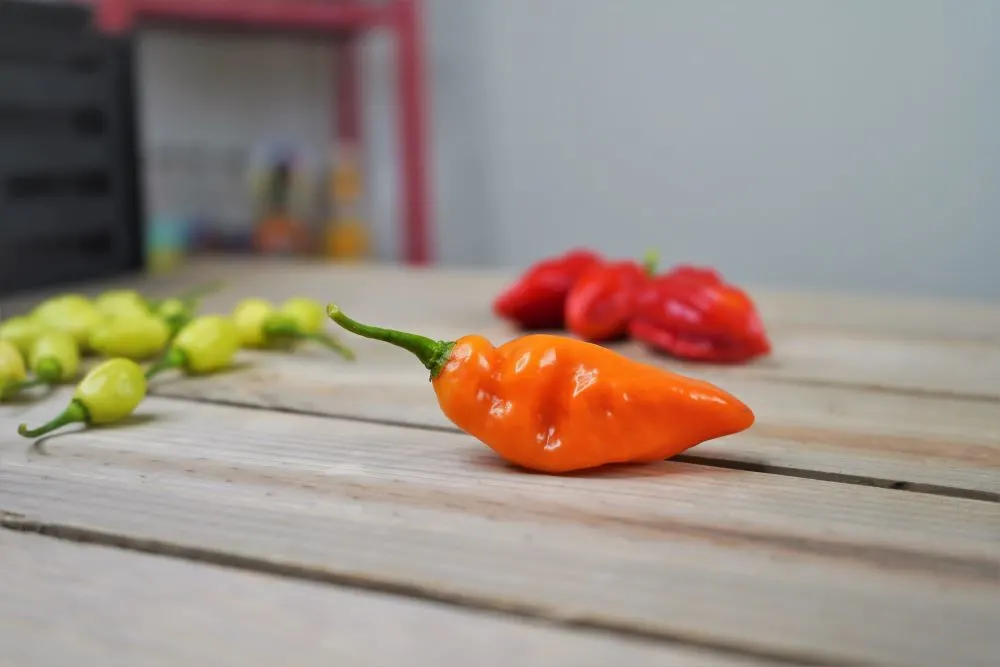We all know about the famous habanero pepper. But have you heard of the habanada pepper? Michael Mazourek of Cornell University developed this variety to have the flavor of a habanero with none of the heat.
The name says it all! While many heat-free peppers exist, the plant breeder had a specific goal with this variety: Keep the floral and fruity flavors of the habanero pepper while removing all of the heat.
The process of creating a new pepper variety takes time. While cross breeding pepper plants is relatively straightforward, stabilizing a new phenotype is tough. The habanada took approximately 13 generations of plants to be considered fully stable.
We love seeing professional and amateur plant breeders develop new pepper types. The variation across the capsicum genus is remarkable, and the habanada pepper continues to popularize the practice.
About Habanada Peppers:
Scoville Heat Units (SHU): 0
Width: 1 – 1.25 inches
Length: 2 – 4 inches
Color: Orange
Species: Capsicum chinense
Buy Seeds: Burpee

In This Article:
- Habanada’s creation
- Characteristics
- Flavor
- Growing habanadas
- Other non-spicy peppers
- Using habanadas
The Habanada Pepper’s Creation
As mentioned, the habanada pepper was developed by Michael Mazourek, a plant breeder at Cornell. He is also known for his work on creating the honeynut squash (a smaller, sweeter variety of butternut squash).
The habanada was finished as early as 2007, but was not widely available until years later.
The process of creating a new pepper variety involves cross-pollinating two compatible plant varieties. In this case, Mazourek crossed the orange habanero plant with a “bad tasting” heat-free pepper variety.
In order to reach a consistently heat-free and flavorful pepper, the plants were grown through 13 full generations. The result is a brand new, stable pepper variety that can be grown year after year.
Habanada Pepper Traits
The habanada pepper is claimed to taste just like a habanero, without any of the heat. It mostly lives up to that claim, but we noticed some differences while growing them.
For one, the habanada plant is slightly less prolific than a standard orange habanero. We still got a lot of peppers off of our plants, but the habanero produces more.
We also found that the habanada plants were lower and wider, while a standard habanero plant is taller and fuller. As a result, the plants were a bit difficult to keep up off of the ground, with leaves tending to droop into the dirt. We could likely have done better about pruning low branches early on.
The shape of the pepper pods is different from standard habaneros. The habanada peppers are smooth like habaneros, but are elongated and curvy.

Most of our habanada peppers measured 3-4 inches, while orange habaneros are typically 1-2 inches. This gives them more of a bhut jolokia (ghost pepper) shape than a standard habanero, but we can see the resemblance.
Mazourek also spoke about the plant needing lower nitrogen levels, consistent watering and warm, full sunlight. With too much nitrogen, most pepper plants can turn into a fruitless bush rather than a bountiful plant.
The flavor is also different than standard habaneros. While habanadas do have some of the aromatic traits of a habanero, the actual taste is very different.
Habanada Pepper Flavor
I love the flavor of orange habanero peppers. They are crisp, fruity and floral, without having an overpowering perfume flavor. This pungent bite is addictive, and pairs perfectly with the intense heat.
Main flavor notes:
- Super sweet
- Slightly floral
- Fruity and bright
- Less aromatic than a habanero (we miss the bite)
With the habanada, the flavor is more mellow and fruity. The flowery aroma is significantly dumbed down, and the pungent flavor is as well. It doesn’t taste bad, but it certainly does not hit the spot the way a spicy habanero does.

Our perceived difference in flavor from normal habaneros could be partially due to bias. To be honest, we really love hot and spicy peppers. However, the habanada’s flavor just feels less rewarding and distinctive than its spicy chinense siblings.
This doesn’t mean that the flavor isn’t interesting. Habanada peppers are totally different from jalapenos, bell peppers, banana peppers and any other common pepper.
If you are looking for a new flavor to cook with, these will be fun for experimenting! Some even suggest using them for dessert…
Growing Habanada Peppers
Growing habanada peppers is ultimately the same as growing any other pepper variety. The original cultivator did mention that the plants prefer low-fertility soil, so keep the nitrogen levels down.
How Long Until Habanadas Are Ripe?
Our habanada plants began producing ripe peppers around the same time as our other sweet pepper plants. Simply put, habanadas take about 80-90 days to produce ripe peppers after transplanting outdoors. This places them somewhere in the middle for grow time of peppers.

Tip: Use Garden.org’s useful tool to see exactly when you should plant pepper seeds in your hardiness zone.
Since the habanada is stable, you can also save your seeds and grow them again the following year. Or, share the seeds with friends to spread this special pepper to a wider audience.
Other Non-Spicy Pepper Varieties
If you are looking for more non-spicy peppers to grow, here are a few ideas. Some are more common, but we tried to choose interesting varieties for you to grow yourself.
Nadapeno
The nadapeno follows the same formula that the habanada pepper does: Remove the heat, but maintain the general shape and flavor of the jalapeno. Jalapenos are not very spicy on the Scoville scale, but some people just don’t like any heat. Try the nadapeno for an un-spicy jalapeno.
Shishito
These Japanese peppers are so versatile for cooking. The thin pepper walls makes them great for snacking, pickling and pan frying. They are great as a side dish, and the plants are impressively productive. Quick to produce, easy to grow and quite photogenic.
Lesya
We grew the lesya sweet pepper variety for the first time in 2020. The plant is not very productive, but the peppers are huge (almost bell pepper sized) and have a gorgeous teardrop shape. The deep red color is also unique, and the flavor is very sweet and juicy.
How To Use Habanada Peppers
While we prefer the super-spicy habanero peppers for flavor, the habanada has its uses in cooking, too. You can substitute habanadas for all of the typical habanero uses (except making food spicy).
- Pickling – The relatively thick walls of the habanada pepper make them great for pickling. Crunchy and sweet, you can use a standard dill pickle recipe for a sweet sandwich topper. Also a great way to preserve your peppers.
- Hot sauce – Use your habanadas to make not-too-hot sauce. Mix them with other mild peppers and fruits to keep the heat level bearable.
- Pepper powder – This pepper is perfect for making homemade pepper powder. Use it as a seasoning to add fruity flavor to soups and stews, stir fry or even dessert!
I hope enjoy specialty pepper varieties as much as we do. The habanada pepper is certainly a special pepper that has inspired us to experiment in our garden and kitchen.


D.A. Hänks
Friday 11th of November 2022
Mine are tiny; 1.5" long. Then again, all my peppers were small this year. Could it be a PK deficiency? I brought the plant in for the winter; I'm thinking some wood ash watered in might help. Thoughts? Love your YouTube vids BTW. You guys are to peppers, what I am to dawn redwoods. Keep it up!
Miguel
Monday 11th of July 2022
Would love to hear about your experience during the hot summer months. It's been impossible for me to grow habanadas here in Georgia from June to Sept. The plant doesn't develop, leaves tend to curl up and flowers keep dropping if they get to form. I've been trying to eliminate other variables like watering, soil deficiencies or toxicities and ruling out diseases, of course you can always do better but it seems to me that they are just not as heat tolerant as the habaneros or other varieties.
Chris
Friday 12th of November 2021
Nice write up. I'm in Oregon and the Farm that I pick up my CSA from had these available a couple weeks ago and i grabbed a quart. I was actually amazed at the flavor and it honestly held up to my expectation of a habanero. The look of them was slightly longer but had all of the curls im used to seeing. None were orange though, all yellow or marbled with green. Very nice citrus and floral with a light melon/tropical note in the background, id argue it was just as much as a habanero and not muted at all. My brain went into prep for burn mode from past experiences but the heat never came. Id imagine growing conditions could change the flavor and shape quite a bit. Ill be adding a couple of these to my garden next spring for sure.
Dan
Tuesday 9th of November 2021
These are fantastic. All the Hab taste, without the burn. HUGELY productive. Giving loads away. We got some thirty peppers off of each plant and then when those were done a HUGE second flush of peppers popped out. As of November in Texas that second flush is big and green, and I'm hoping they can finish ripening. They are late in maturation. Be aware of that. We were eating other peppers when these were just finished flowering. These are not big plants. Somewhat bushy and about 18 inches tall. Note that occasionally you'll find a very slightly spicy Habanada, but most have zero spice. The genes for capsaicin are still there, but they're just not turned on. I'll be growing these every year. It is kind of funny terrorizing people with these. They look exactly like Habaneros.
Ron
Friday 13th of August 2021
On your dessert comment, I made a coconut habanada pie the other day. I'd been making coconut habanero pie for years. With no heat, I was able to increase the volume of peppers used and the pie turned out great.
peppergeek
Saturday 14th of August 2021
Intriguing idea...spicy pie